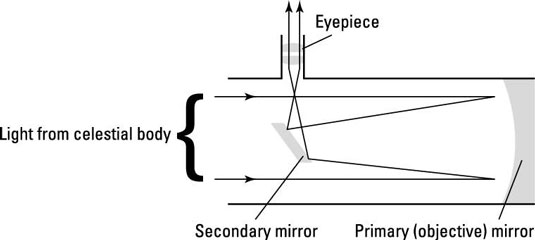The main difference between a refracting and a reflecting telescope is that a refracting telescope uses lenses to gather and focus light and a reflecting telescope uses mirrors. The telescope was probably invented in the Netherlands in 1608 when a spectacle-maker Hans Lipperhey put two glass lenses together in a tube effectively creating a refracting telescopeIn 1609 Italian scientist Galileo Galilei heard of this optical device and went on to develop refracting telescopes with magnifications able to observe the solar system in great detail.
 Reflecting Vs Refracting Stargazing Telescopes Dummies
Reflecting Vs Refracting Stargazing Telescopes Dummies
3Reflecting telescopes can be made much larger than refracting telescopes.
Refracting and reflecting telescopes. The light enters a refracting telescope through the front lens called the objective lens. For viewing terrestrial and. Reflectors have several advantages over refractors.
Like the compound microscope this telescope has an objective and an eyepiece. 1Reflecting telescopes use mirrors while refracting telescopes use lenses. 2Refracting telescopes require a much purer material than reflecting telescopes.
To know which one is best for you the functionality or purpose of the telescope comes into play. 4Reflecting telescopes suffer less from aberrations than refracting telescopes. Also the telescope tube of a reflector is shorter than that of a refractor of the same diameter which reduces the cost of the tube.
A refracting telescope or a refractor uses a combination of lenses to produce images of distant objects eg stars and planets that would otherwise not be visible with the human eye. The refracting telescope uses a combination of lenses to form an image and the reflecting telescope uses a curved mirror and a lensThe lens combination shown in Figure is that of a refracting telescope. Unlike their catoptrics counterparts refractors they use lenses as objectives in order to form visible images.
Telescopes are designed to focus light using refracting lenses or reflecting mirrors. Whereas Reflector telescopes are best suited for observing dimly lit deep-sky objects like low magnitude stars clusters nebulas and the like. A refracting telescope on the other hand focuses light from one end to another using lens.
In a Refracting telescope we have a pair of lenses that focus the light and the objects appear closer than they really are. The main difference between a reflecting and refracting telescope lies in how they work to magnify the image by manipulating light. Reflecting telescopes have a number of other advantages over refractors.
Difference between the refracting telescope and reflecting telescope purpose. Use of multiple mirrors. This means a Reflecting telescope is a lot cheaper to produce than that of a Refractor.
In fact you can think of a refracting telescope as one half of a giant pair of binoculars. The result is that a stronger performing Reflector telescopes is available for less money than a Refractor equivalent. Reflecting telescopes are generally built with two mirrors a large one called the primary mirror and a small one called the secondary mirror The primary mirror is usually placed at one end of the telescopes tube and the secondary mirror is placed in the eyepieces line of sight.
In this video we explore the differences between refracting and reflecting telescopesSupport me on Patreon. A simple refracting telescope is made up of two lenses which are called the objective and the eyepiece. Refracting telescopes are sometimes called dioptric telescpes.
A typical layout of a refractor includes a lens located at its front side that is connected via a tube and lastly ending with an eyepiece at its rear. Lets recall it here. Disadvantages of Reflector Telescopes.
While reflectors can have large mirrors for better light collection refractors have good contrast and sharpness are light and transportable and need little to no. Reflecting vs Refracting Understand the advantages of reflecting telescopes compared to refracting telescopes in terms of. The majority of professional and amateur telescopes are reflectors.
Using large aperture objectives. This means you can purchase more magnification power for less. Although reflecting telescopes produce other types of optical aberrations it is a design that allows for very large diameter objectives.
The reflecting telescope was invented in the 17th century by Isaac Newton as an alternative to the refracting telescope which at that time was a design that suffered from severe chromatic aberration. They are not subject to chromatic aberration because reflected light does not disperse according to wavelength. They are both curved but they display different affects on the telescope.
Refracting telescopes use lenses to collect and focus the light just like binoculars do. Very long focal lengths. Every one of us has once in our lifetime read or studied the principle of refraction.
The refracting telescope design was originally used in spy glasses and astronomical telescopes but is also used for long focus camera lenses. From a general viewing perspective Refractor telescopes work well for viewing brighter objects like the moon and planets. While the refracting telescope uses a lens that you can see through the reflecting telescope a mirror.
A reflecting telescope is primarily made up of a mirror that bounces off the light onto a smaller focus area. A refracting telescope also called a refractor is a type of optical telescope that uses a lens as its objective to form an image also referred to a dioptric telescope. The smallest telescopes are often designed to use lenses but in most cases mirrors are more affordable when using larger telescopes.
The telescopes have lenses as their optics are known as Refracting Telescopes.